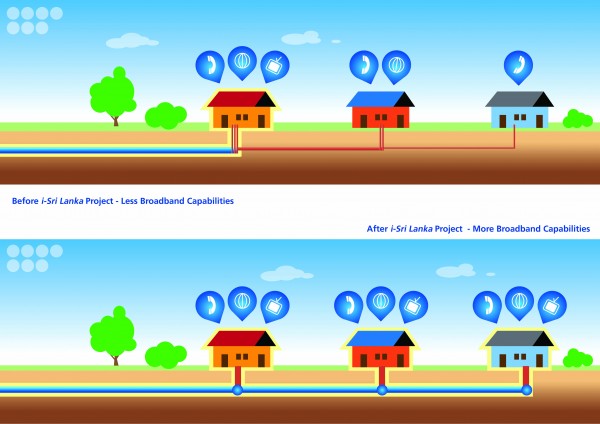To improve Country’s Broadband experience

Sri Lanka Telecom, the nation’s number one integrated communications service provider and the leading broadband & backbone infrastructure services provider, is proud to announce the successful implementation of the 1st phase of its ultra-high speed Broadband Network under its nation-wide network modernization project “i-Sri Lanka” which has already driven an increase of 40,000 new broadband connections to the network.
The i-Sri Lanka project is due to be fully completed within a period of 18 months, at which time it will provide ultra-high speed broadband 20Mbps service to more than 90% of our customers by adding capacity for 600,000 new broadband customers to the network. Through the completion of the i-Sri Lanka project, SLT plans to increase the existing customer base of 300,000 customers to 600,000 over the next couple of years to ensure the 1 million SLT Megaline customers can enjoy broadband and PeoTV (triple play) services.
The i-Sri Lanka project was kicked-off in 2011 to enhance and upgrade SLT’s existing fixed network, by expanding the fibre network to bring it closer to customers through Fibre-to-the-Node (FTTN) deployment of Multi-Service Access Nodes (MSANs), located within short distances from customers. This reduces the length of the copper connection with a resultant significant increase in reliability, quality and broadband data speeds. Reducing the copper cable lengths not only improves reliability, but will reduce maintenance and replacement costs. Through this programme SLT has already brought ultra high speed broadband connectivity at speeds of up to 20Mbps for many of its fixed customers. This programme is fully integrated with the company’s Next Generation Network (NGN) modernization project. In addition, most importantly, this expansion will bring SLT’s interactive PeoTV, the multi channel TV network to all Megaline customers for the first time.

Mr. Greg Young, CEO of SLT commenting on the i-Sri Lanka project said, “We are delivering against our Strategy to evolve a world class broadband access network accessible to all Sri Lankans, to increase broadband penetration, which directly contributes to economic growth of the Country. To achieve the predefined goals of the project, we are transforming the traditional, copper based access network architecture to a high speed capable broadband network via NGN and FTTX technologies”.
With this ongoing i-Sri Lanka project, the Company has addressed key network limitations due to inherent characteristics of the older copper network, affordability of services and limited options for the future, which has limited broadband penetration in Sri Lanka. With this modern network architecture, SLT converts its street Cabinets to Access Gateways to provide improved High Speed Broadband, PeoTV IPTV and to add additional capacity to the network to cater to the growing customer base.
Despite a global trend of declining fixed line subscribers, SLT has consistently driven a steady increase in fixed customers over the last 3 years. The Company’s impressive product range and the demand for high speed uninterrupted Broadband and entertainment through PEO TV has seen fixed PSTN line (SLT Megaline) customers steadily increase. The demand for high speed uninterrupted broadband has fuelled the company’s strategy to deliver double-play and triple-play services, which has contributed to ongoing growth in our fixed customer base and revenues.
According to the CBSL Socio – Economic Report 2011 & TRCSL, both Fixed and Mobile Broadband Penetration as at end 2011 were 4.0 % (844,000 subscribers including 1.7% Fixed Broadband Penetration & 2.3% Mobile Broadband Penetration). At present, Less than 50% of SLT fixed line (SLT Megaline) customers currently have access to IPTV (PeoTV) and 2Mbps (or higher) broadband. Sri Lanka fixed and wireless broadband penetration is below the developing countries and only a fraction of world average. SLT expects and will drive substantial growth in Sri Lanka broadband over the coming years.
Elaborating further Mr. Young said, “The i-Sri Lanka approach is to increase the Broadband bandwidth (speed) and footprint (expand services) – 90/20 (90% coverage at 20Mbps), improve Broadband Quality of Service, optimise investment, improve operational efficiency by reducing maintenance and operational costs, improving network reliability; whilst growing the customer base and expanding into under-served areas, to grow market share”.
Keywords
FTTN – Fiber-to-the-node – fiber is terminated in a street cabinet up to several kilometers away from the customer premises, with the final connection being copper. Fiber-to-the-node is often seen as an interim step towards full FTTH and is currently used to deliver advanced triple-play services (of voice, super fast broadband & high definition television).
FTTC – Fiber-to-the-curb / Fiber to the cabinet – this is the same as FTTN.
FTTB – Fiber-to-the-building or Fiber-to-the-basement – fiber reaches the boundary of the building, such as the basement in a multi-dwelling unit, with the final connection to the individual living space being made via copper wiring inside the building.
FTTH – Fiber-to-the-home – fiber reaches the boundary of the living space, typically terminating on a box on the outside wall of a home. It is capable of delivering up to 100 Mbps (megabits per seconds) or greater.
Vast economic benefits can be realised through reliable telecommunication infrastructure capable of adequately catering to the immediate and long term information technology needs of a developing nation and seeking to tap into global IT markets. Improved ICT infrastructure has the potential to enable a smarter workforce, improve efficiencies through reduced travel, fast and simple access to government and other information services produce a well informed population, enable high quality jobs and educated citizens to fill them, pave a road away from poverty and promote life-long learning. Needless to say, ICTs are not a magic pill, nor an alternative to other development investments, but if applied in conjunction with other initiatives, they are a crucial enabling factor for development in Sri Lanka.







GIPHY App Key not set. Please check settings